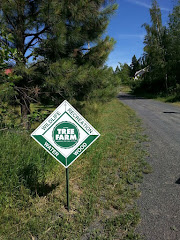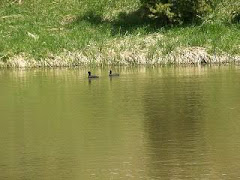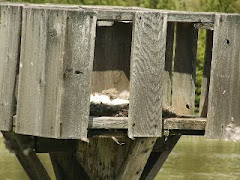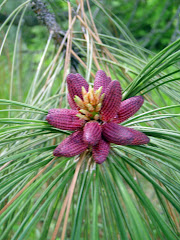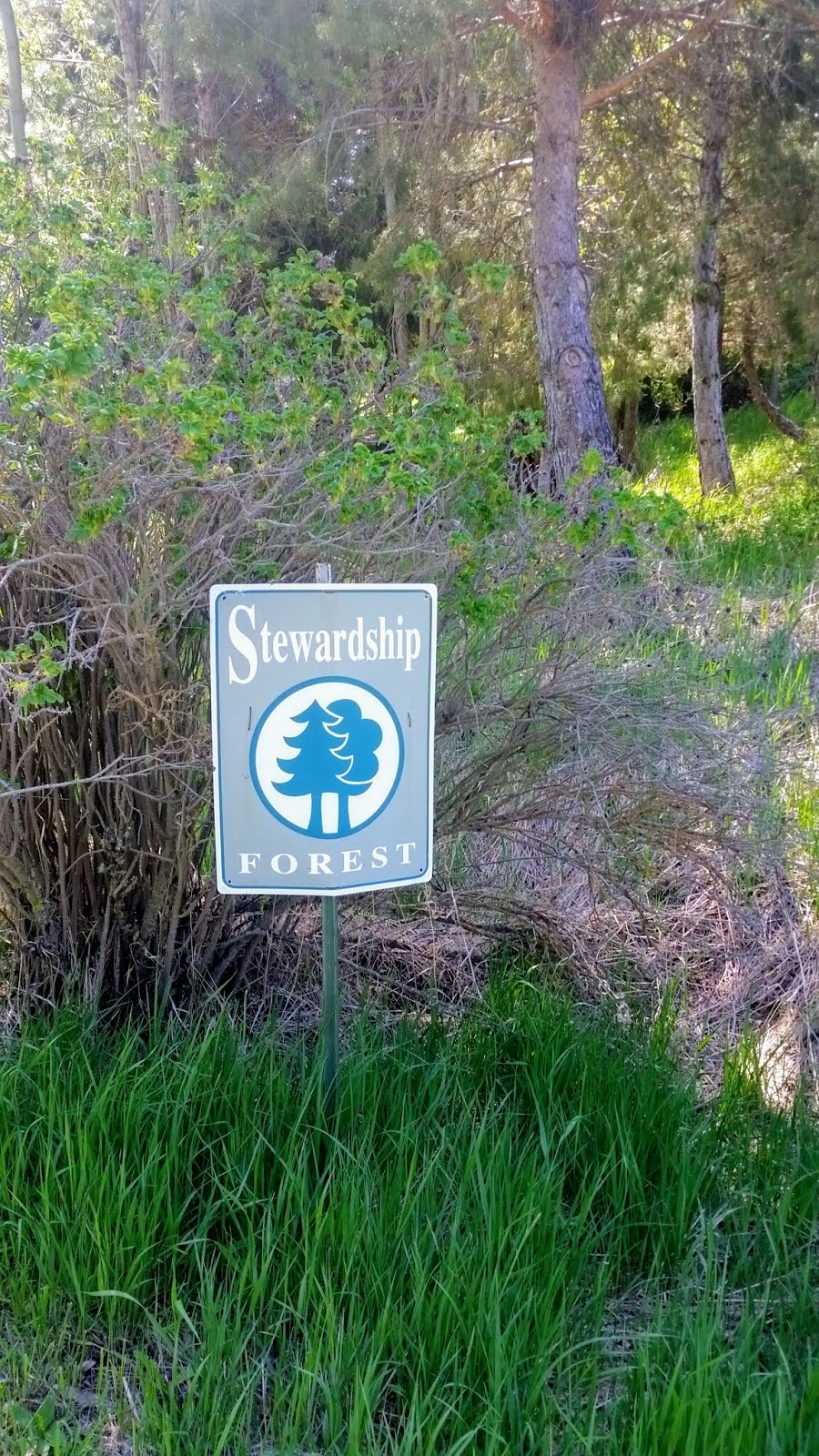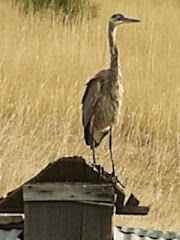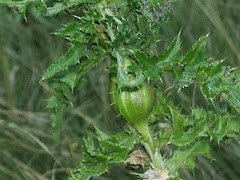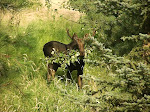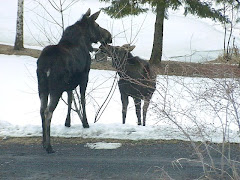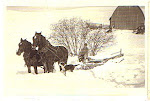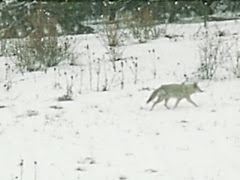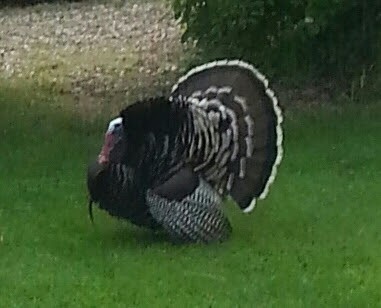Introduction
Blue Dog Ranch LLC is our forested 81.51 acres/33 hectares including homestead with outbuildings and pasture. We're certified as a Stewardship Forest under the Idaho Department of Lands Forest Stewardship Program. We're also certified for meeting American Forest Foundation standards relating to carbon storage, clean air and water, wildlife habitat, sustainable forest products and mitigation of wildfires. Wood from certified forests meets Sustainable Forestry Initiative standards and qualifies for SFI labeling.
• Temperatures are typically highest in July and August (average high 85° F), lowest in December and January (average low 24° F) .
Seedling Selection
• We follow published seed transfer guidelines.
• We like the caliper, lignification and root systems of plug+1 bareroot transplant seedlings.
• We chose species appropriate to our soils, climate and objectives.
1. ponderosa pine (western yellow pine; Pinus ponderosa). Thick bark helps withstand low intensity surface fire.
2. Douglas-fir (red fir; Pseudotsuga menziesii). Thick-barked.
Blue Dog Ranch LLC is our forested 81.51 acres/33 hectares including homestead with outbuildings and pasture. We're certified as a Stewardship Forest under the Idaho Department of Lands Forest Stewardship Program. We're also certified for meeting American Forest Foundation standards relating to carbon storage, clean air and water, wildlife habitat, sustainable forest products and mitigation of wildfires. Wood from certified forests meets Sustainable Forestry Initiative standards and qualifies for SFI labeling.
Geography
We're on the eastern aspect of the Palouse, a distinct geographic region of the northwestern US comprising parts of north central Idaho and southeastern Washington. Our elevation ranges from 2820 to 3125 feet; average slope is 30%. Our soils are moderately deep to very deep loams and silt-loams formed over thousands of years in loess over granite bedrock representing a northern reach of the Idaho Batholith. Palouse hills show dune-like form and distinct alignment, with gentle southwest-facing slopes and steeper northeast-facing slopes.
ClimateWe're on the eastern aspect of the Palouse, a distinct geographic region of the northwestern US comprising parts of north central Idaho and southeastern Washington. Our elevation ranges from 2820 to 3125 feet; average slope is 30%. Our soils are moderately deep to very deep loams and silt-loams formed over thousands of years in loess over granite bedrock representing a northern reach of the Idaho Batholith. Palouse hills show dune-like form and distinct alignment, with gentle southwest-facing slopes and steeper northeast-facing slopes.
• Temperatures are typically highest in July and August (average high 85° F), lowest in December and January (average low 24° F) .
• Annual precipitation (rain and snow; 10 inches of snow typically yields about an inch of water) ranges from 14 to 30 inches, about 85% in late fall, winter and early spring.
• Humidity is generally low: average afternoon humidity is 20% in July, 69% in January.
• Average day length (sunrise to sunset) varies from about 16 hours at summer solstice to about 8-1/2 hours at winter solstice.
• Frost line depth is 30 inches.
Watershed
A spring-fed pond on our upper eastern boundary is among the headwaters of the South Fork of the Palouse River. A seasonal creek originates in the pond, collects runoff from a 50-acre basin and fills a pond near our western boundary; the water then makes its way via the Palouse, Snake and Columbia rivers to the sea. Rain and the melting snow pack cause peak runoff in early spring. We planted red ozier dogwoods and six species of willows in the creek bed as living check dams, remediating bank cutting by accumulating sediment and dissipating the force of the water. This promoted revegetation, the foundation of streambed stability.
A spring-fed pond on our upper eastern boundary is among the headwaters of the South Fork of the Palouse River. A seasonal creek originates in the pond, collects runoff from a 50-acre basin and fills a pond near our western boundary; the water then makes its way via the Palouse, Snake and Columbia rivers to the sea. Rain and the melting snow pack cause peak runoff in early spring. We planted red ozier dogwoods and six species of willows in the creek bed as living check dams, remediating bank cutting by accumulating sediment and dissipating the force of the water. This promoted revegetation, the foundation of streambed stability.
Wildlife
Water, forage, cover and range are the fundamental wildlife habitat requirements. Our ponds, woods and fields are used by deer, moose, coyotes, turkey, pheasant, quail, geese, ducks, hawks, woodpeckers and a large variety of songbirds. We've seen one cougar. A meadow and a mile-and-a-half of hedgerow add habitat diversity. There's a time each spring when myriads of butterflies appear and decorate the air like floating flowers. We erected a goose nesting box at the edge of the upper pond; one spring we were lucky enough to be present when the goslings bailed out to join their parents on the pond for their first swim.
Water, forage, cover and range are the fundamental wildlife habitat requirements. Our ponds, woods and fields are used by deer, moose, coyotes, turkey, pheasant, quail, geese, ducks, hawks, woodpeckers and a large variety of songbirds. We've seen one cougar. A meadow and a mile-and-a-half of hedgerow add habitat diversity. There's a time each spring when myriads of butterflies appear and decorate the air like floating flowers. We erected a goose nesting box at the edge of the upper pond; one spring we were lucky enough to be present when the goslings bailed out to join their parents on the pond for their first swim.
History
Before agriculture came to the eastern Palouse, fescues and bluebunch wheatgrass were the dominant grasses. Ponderosa pine prevailed at the lower timberline with a rich shrub understory characterized by ninebark, oceanspray, serviceberry, snowberry and wild rose. Tree cover on the ridges was sparse with large trees in an open setting. Low-intensity ground wildfires tended to occur at frequencies of 15 to 25 years, clearing the forest floor of vegetation, debris and weaker trees, reducing the frequency of stand-replacement conflagrations.
Before agriculture came to the eastern Palouse, fescues and bluebunch wheatgrass were the dominant grasses. Ponderosa pine prevailed at the lower timberline with a rich shrub understory characterized by ninebark, oceanspray, serviceberry, snowberry and wild rose. Tree cover on the ridges was sparse with large trees in an open setting. Low-intensity ground wildfires tended to occur at frequencies of 15 to 25 years, clearing the forest floor of vegetation, debris and weaker trees, reducing the frequency of stand-replacement conflagrations.
Our ground was cultivated in 1887 and became a family farm, growing wheat, oats, barley and hay; raising cows, pigs and chickens. There are apple, plum, and pear trees, berry patches, and mature woodlots. The barn, hand-hewn white pine post-and-beam construction with hayloft, arch roof and cupola, was built in 1911, the house in 1917. The barn has six milking stanchions and a hay trolley in the loft. Rural electrification came in 1948.
In 1987 the farm was enrolled in the US Department of Agriculture (USDA) Conservation Reserve Program (CRP), taken out of crop production and planted to grasses (red fescue, sheep's fescue) and forbs (birdsfoot trefoil, small burnet). In 1997 we re-enrolled in CRP with a reforestation project expressed in a Forest Stewardship Management Plan written with our Idaho Department of Lands Private Forestry Specialist. We also participated in the Idaho Department of Fish and Game Habitat Improvement Program. From 1997 to 2000 we planted 30,000 trees. In 2007 we renewed our CRP contract for ten more years. We updated our forest management plan with IDL in 2015.
In 1987 the farm was enrolled in the US Department of Agriculture (USDA) Conservation Reserve Program (CRP), taken out of crop production and planted to grasses (red fescue, sheep's fescue) and forbs (birdsfoot trefoil, small burnet). In 1997 we re-enrolled in CRP with a reforestation project expressed in a Forest Stewardship Management Plan written with our Idaho Department of Lands Private Forestry Specialist. We also participated in the Idaho Department of Fish and Game Habitat Improvement Program. From 1997 to 2000 we planted 30,000 trees. In 2007 we renewed our CRP contract for ten more years. We updated our forest management plan with IDL in 2015.
Virtues
Living trees provide ecosystem services including production of oxygen, water and air purification, soil erosion control, watershed protection, wildlife habitat, biodiversity, and carbon storage, a critical element of climate change mitigation. The website www.itreetools.org estimates the annual value of environmental benefits provided by a representative living adult north Idaho tree at $178; this includes stormwater runoff savings, air quality improvement savings, and carbon dioxide reduction savings. Benefits not included in the calculation include reduction of erosion, windbreak value, wildlife habitat and aesthetic value.
Harvested trees provide current and emerging wood products including sawn timber, oriented strand board, laminated veneer, medium density fiberboard, paper, cross-laminated timber, nanocellulose, cellulosic sugars, pyrolysis oil, insulating wood fiber and substrates for 3-D printing.
• We follow published seed transfer guidelines.
• We like the caliper, lignification and root systems of plug+1 bareroot transplant seedlings.
• We chose species appropriate to our soils, climate and objectives.
1. ponderosa pine (western yellow pine; Pinus ponderosa). Thick bark helps withstand low intensity surface fire.
2. Douglas-fir (red fir; Pseudotsuga menziesii). Thick-barked.
3. western larch (western tamarack; Larix occidentalis). Thick-barked.
4. Engelmann spruce (Picea engelmanni)
5. lodgepole pine (Pinus contorta)
Planting
• We planted over a 4 year period to minimize annual cost and risk of loss due to unpredictable events like vole population explosions - see Voles.
Pruning
Pruning reduces crown-fire risk by removing ladder fuel and increasing height to the base of the crowns. Benefits and costs increase with pruning height (we never remove more than the lower third of the live crown). Pruning during the dormant period from late winter to early spring reduces potential for entry by insects or pathogens.
Planting
• We planted over a 4 year period to minimize annual cost and risk of loss due to unpredictable events like vole population explosions - see Voles.
• We planted in spring when the soil warms to 40°, around the first week in April.
• We plant with hoedads (Rindt hoes) - wide blade for scalping, long blade for digging.
Voles
In April 1998 the vole (meadow mouse) population, normally about 5 per acre, exploded. We coudn't take a step without flushing voles. Vole highways were visible everywhere. Vole densities have been reported as high as 25,000 per acre. Explaining these unpredictable fluctuations (the microtine cycle) is a central challenge in population ecology. We had planted 10,000 small seedlings (4 cubic inch plugs) in early April; we estimate that the voles ate about 9000 of them.
We tried wrapping surviving seedlings in foil, protecting seedlings in tubes, and erecting raptor perch-poles; ultimately concluding that the most cost-effective response to vole voracity is replanting the following year.In April 1998 the vole (meadow mouse) population, normally about 5 per acre, exploded. We coudn't take a step without flushing voles. Vole highways were visible everywhere. Vole densities have been reported as high as 25,000 per acre. Explaining these unpredictable fluctuations (the microtine cycle) is a central challenge in population ecology. We had planted 10,000 small seedlings (4 cubic inch plugs) in early April; we estimate that the voles ate about 9000 of them.
Weeds
Certain weeds are defined by state law as noxious/invasive and control is required.
Weeds are generally shade-intolerant. Canada thistle growth, for example, is reduced when light is less than 60 to 70% of full daylight, and death occurs when light is less than 20%. On a tree farm canopy cover is crucial to efficient long-term weed management.
Mechanical weed management consists of clipping (whacking, mowing): weakens plants by reducing leaf area, curtailing photosynthetic manufacture of energy. Timely clipping also prevents weeds from going to seed. Invasive multiflora rose bushes too big to clip can be dug or bulldozed out with the loader bucket on the tractor; when that fails we wrap a chain around the base and pull them out.
Our chemical weed management consists of selective broadleaf systemic translocating herbicide. Selective broadleaf herbicides spare grasses - weed management is optimal insofar as it promotes competitive desirable species. Systemic translocating herbicides are absorbed by foliage and move readily through the plant to stems, roots and underground storage tissues, valuable for managing rhizomatous colony-forming weeds like Canada thistle. We spray with an ATV fitted with a 25 gallon tank, a 5-foot boom and a gun on a 20-foot hose. We choose nozzles, spray height and pressure to minimize drift and waste and we spray when the wind isn't over 2 on the Beaufort scale.
Our chemical weed management consists of selective broadleaf systemic translocating herbicide. Selective broadleaf herbicides spare grasses - weed management is optimal insofar as it promotes competitive desirable species. Systemic translocating herbicides are absorbed by foliage and move readily through the plant to stems, roots and underground storage tissues, valuable for managing rhizomatous colony-forming weeds like Canada thistle. We spray with an ATV fitted with a 25 gallon tank, a 5-foot boom and a gun on a 20-foot hose. We choose nozzles, spray height and pressure to minimize drift and waste and we spray when the wind isn't over 2 on the Beaufort scale.
Certain weeds may be managed most efficiently by doing nothing. St. John's Wort, for example, attracts Chrysolina beetles. The beetles feed on the foliage and flower buds. When the stand is depleted the beetles depart. After a few years the St. John's Wort re-establishes, the beetles return, and so on. This is natural biological weed management.
Pruning reduces crown-fire risk by removing ladder fuel and increasing height to the base of the crowns. Benefits and costs increase with pruning height (we never remove more than the lower third of the live crown). Pruning during the dormant period from late winter to early spring reduces potential for entry by insects or pathogens.
Thinning
Thinning reduces crown-fire risk by separating crowns and by selecting for the largest (most fire resistant) trees. The best time to thin is during the period of bark beetle inactivity from August through December. Considerations include temporarily relinquished tree canopy cover and diminished stand density in relation to wind and snow damage.
Thinning reduces crown-fire risk by separating crowns and by selecting for the largest (most fire resistant) trees. The best time to thin is during the period of bark beetle inactivity from August through December. Considerations include temporarily relinquished tree canopy cover and diminished stand density in relation to wind and snow damage.
Slash Treatment
Slash is the surface debris generated by thinning and pruning. Slash provides benefits associated with organic mulch: enhances soil moisture, structure and organic matter; recycles nutrients; reduces erosion. Accumulations of slash serve as "critter condos," providing some of the wildlife habitat functions of down logs in older forests. Our primary slash treatment goals are to lower the fuel level, promote decomposition and discourage bark beetle infestation.
EQIP Project
In autumn 2019 we completed an Environmental Quality Incentives Program (EQIP) Wildfire Hazard Fuel Reduction project in collaboration with USDA NRCS and IDL on 4 acres adjacent to the homestead: thinned to 20-foot average spacing, pruned to 8 feet, hauled firewood, chipped and scattered larger remaining slash.
Postscript
Research shows that trees communicate and cooperate, informing and supporting each other both intra-species and inter-species, sending and receiving goods like water and nutrients and services like insect and disease warnings via the “wood wide web” of mycorrhizal fungi. This collaboration is net beneficial to the well-being of the plant community.
Research shows that trees communicate and cooperate, informing and supporting each other both intra-species and inter-species, sending and receiving goods like water and nutrients and services like insect and disease warnings via the “wood wide web” of mycorrhizal fungi. This collaboration is net beneficial to the well-being of the plant community.
 Stu and Woolie Nelson
Stu and Woolie NelsonSupposing a tree fell down, Pooh, when we were underneath it?
Supposing it didn't, said Pooh after careful thought.
Piglet was comforted by this.
- A.A. Milne



